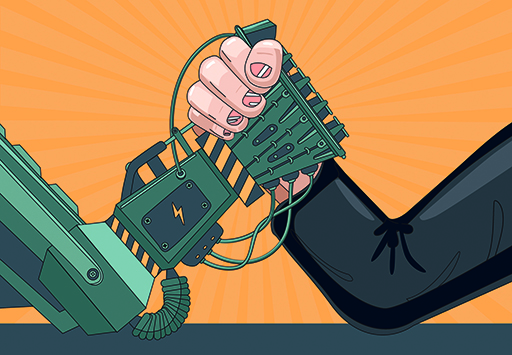10 things about... automated dispensing
In Running your business
Follow this topic
Bookmark
Record learning outcomes
If it feels like computers are taking over the world, it’s because they are, but there are benefits from letting hard drives do the hard work...

From digitised patient records to real-time ordering of stock, lots of tasks can be carried out in a pharmacy faster and more accurately by a machine than a human, including – perhaps controversially – the automated dispensing of medicines. Apart from freeing up the pharmacy team to spend more time with customers, here are some things you might not know about ‘pharmacy robots’.
1. German origins
Automatic dispensers were developed in Germany in the mid-90s and displayed for the first time by Rowa and Willach at Munich’s Expopharm pharmacy show. What else would we expect from German engineering!
2. European reach
An estimated 30 to 40 per cent of pharmacies in mainland Europe use automated dispensing. In contrast, says Steve Rigby, sales manager at Robotik Technology UK, less than 10 per cent of UK pharmacy is automated – and that’s across all community, hospital and prison settings. So we possibly have some catching up to do.
3. Faster dispensing
The time saved by pharmacy robots depends on the type of machine and task, according to Mr Rigby. Take MDS, for example: “For a human to make up one tray can take up to half an hour, but a robot can do it in three minutes. And pouch machines are even quicker: in one hour a human can make up pouches for 10 patients, but the machine can do 50 to 60.”
4. The CPO view
In 2016 England’s chief pharmaceutical officer Keith Ridge said community pharmacists had a “professional obligation” to adopt automated dispensing because research showed “the level of error is reduced to a tiny fraction of current manual dispensing error rates”. However, PSNC disputed that claim, stating that lack of explanation of the types of error identified in the research could “overstate the likely beneficial impact of automated dispensing systems on dispensing accuracy”. The situation remains unresolved.
5. Affordability
Smaller machines start from £50,000, ranging up to £500,000 for large units, and they can also be rented. Users say that robots pay for themselves within a few years, versus the cost of employing someone. Costs have begun to reduce over recent years, potentially making automation more accessible.
6. Robots in healthcare
A robot doesn’t take a tea break or refuse overtime, which are all reasons why the NHS is using more of them. “We are seeing more hospitals choosing pack dispensing machines now, especially the PFI hospitals which came with robots already installed”, says Mr Rigby, “and I’ve seen tenders and frameworks recently which suggest a wider trend for automation in the NHS.”
7. Hub and spoke
Some pharmacies use robots to operate a dispensing hub, and for internet-only pharmacies this is certainly the case. It’s also a way of testing out the technology. “Clients with multiple branches automate in one and see how it goes,” says Mr Rigby. “Others rent a secure location for their robot rather than taking up branch space, then get a driver to deliver to branch or to patients from there.”
8. Long arms of the robot
The robotic arm is the most expensive part of the equipment, so most pharmacies opt for a robot with just one. Some hospital robots can have a reach of up to seven metres.
9. The robot brain
Although robots don’t tire, Mr Rigby warns there is a trade-off between speed and accuracy: “Robot dispensers can only be pushed so far, so if they extend beyond the limit of their capabilities they can start to make mistakes.” Like humans, even machines aren’t invincible.
10. Call me HAL
Weldricks runs a ‘name the robot’ competition with local schools, and initiatives such as this can generate press coverage for your new addition, as well as patient interest. And, in case you are wondering, a quick poll for this feature found that ‘Robbie’ is, indeed, a very common choice of name!
Robots in practice
Fin McCaul was an early adopter of pharmacy robots, installing a packet dispenser in his Prestwich Pharmacy in Manchester back in 2006.
“We decided to get a robot for a couple of reasons,” he explains. “Because electronic prescriptions were coming we felt we could use it to service two dispensaries: one for EPS and one for walk-ins. And it was safer: no picking errors, only labelling errors.”
But it wasn’t plain sailing right from the start. Mr McCaul says it was a real challenge for everyone to get used to the robot: “In fact, it wasn’t until EPS that we could use the robot as we really wanted, and now EPS is running smoothly we’ve changed all of our processes to work around the robot.”
And the robot certainly gets put to work. It dispenses while the pharmacy is open from 8am to 6pm, as well as putting away orders when it’s quiet, and at night it restocks, so it’s operational for about 16 hours a day. “This has taken us away from stock management and processing to enable us to be more label focused, prescription focused and patient focused,” says Mr McCaul.
Despite its 12-year residency, some staff are still wary of the robot – which they nicknamed ‘Psycho’ in the early days – but the public response has been great. “We have a glass floor so customers can see it operating above their heads,” says Mr McCaul, “kids love it – they’d lay on the floor and watch it all day long.”
